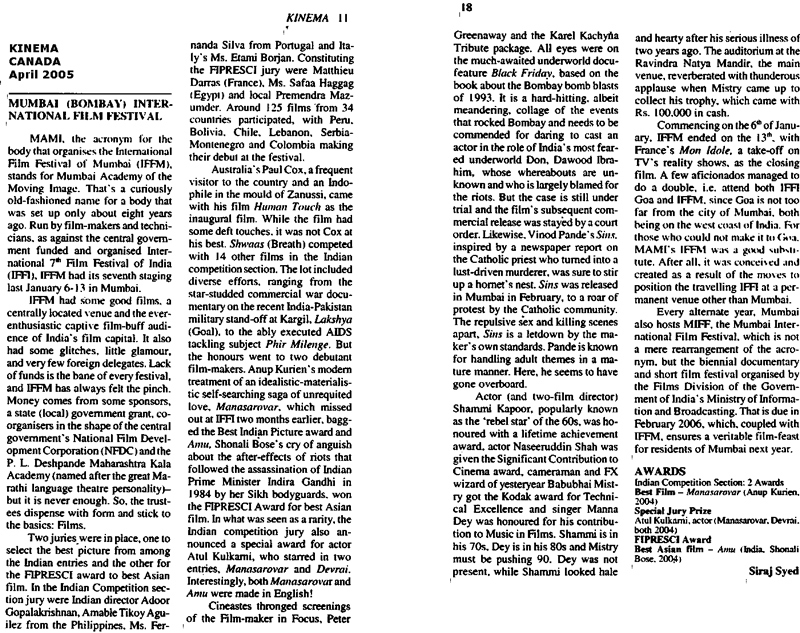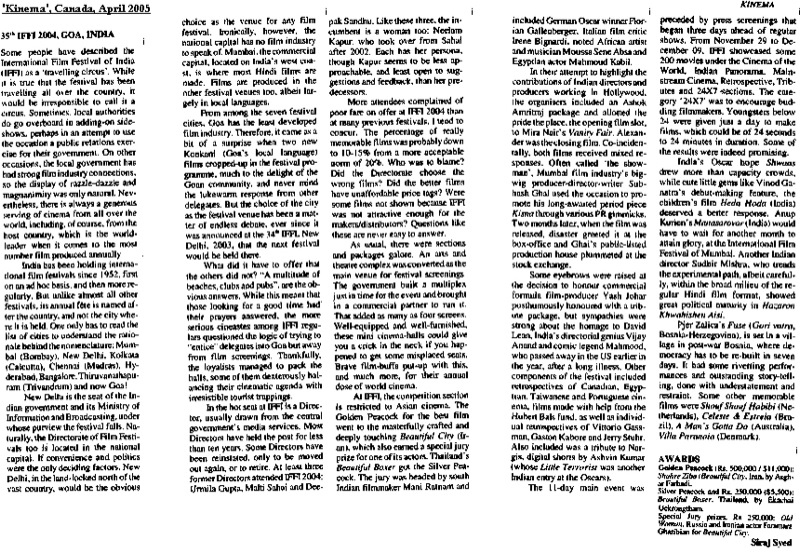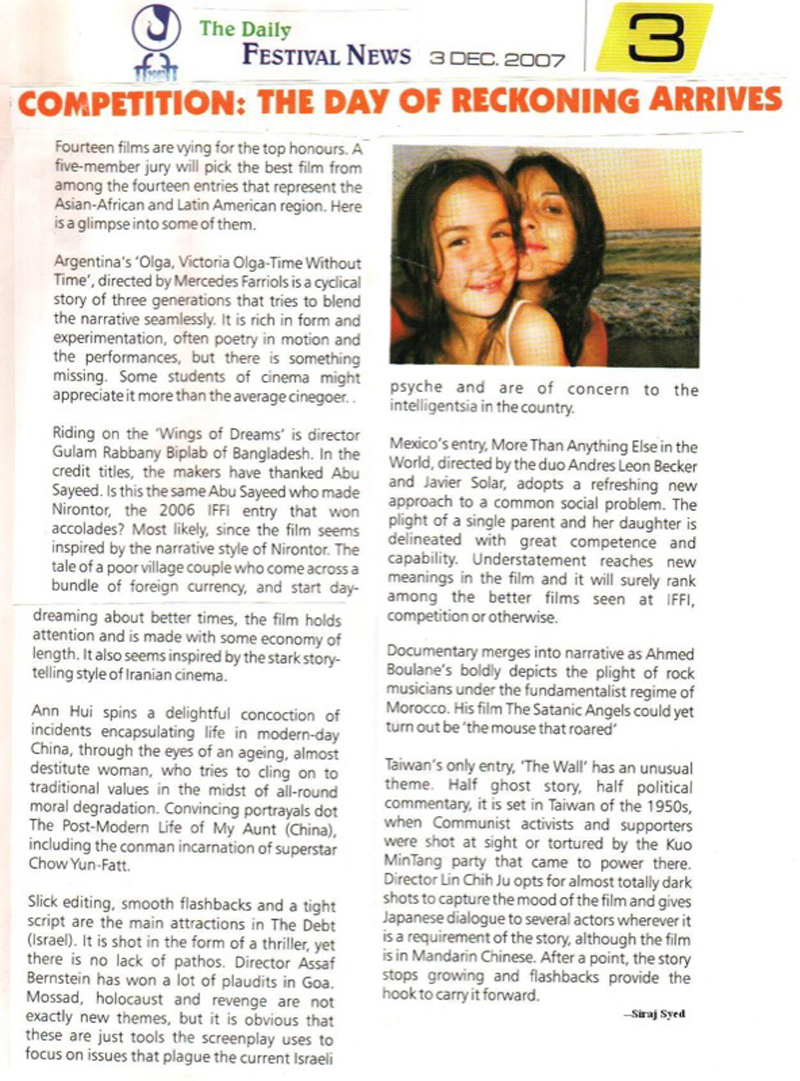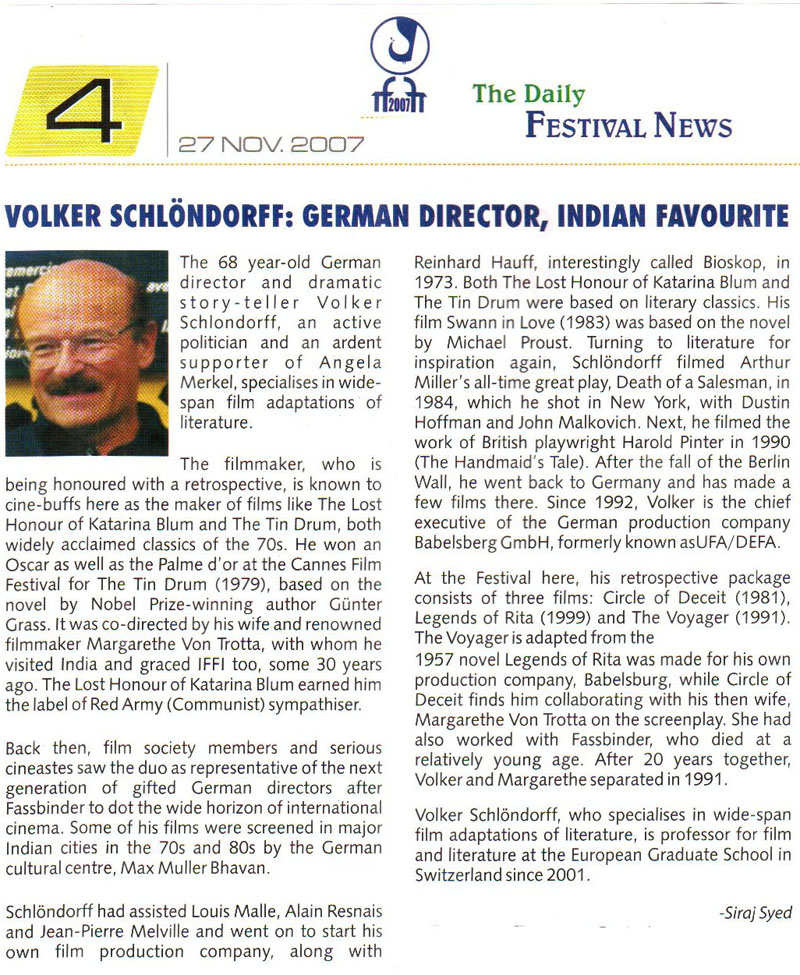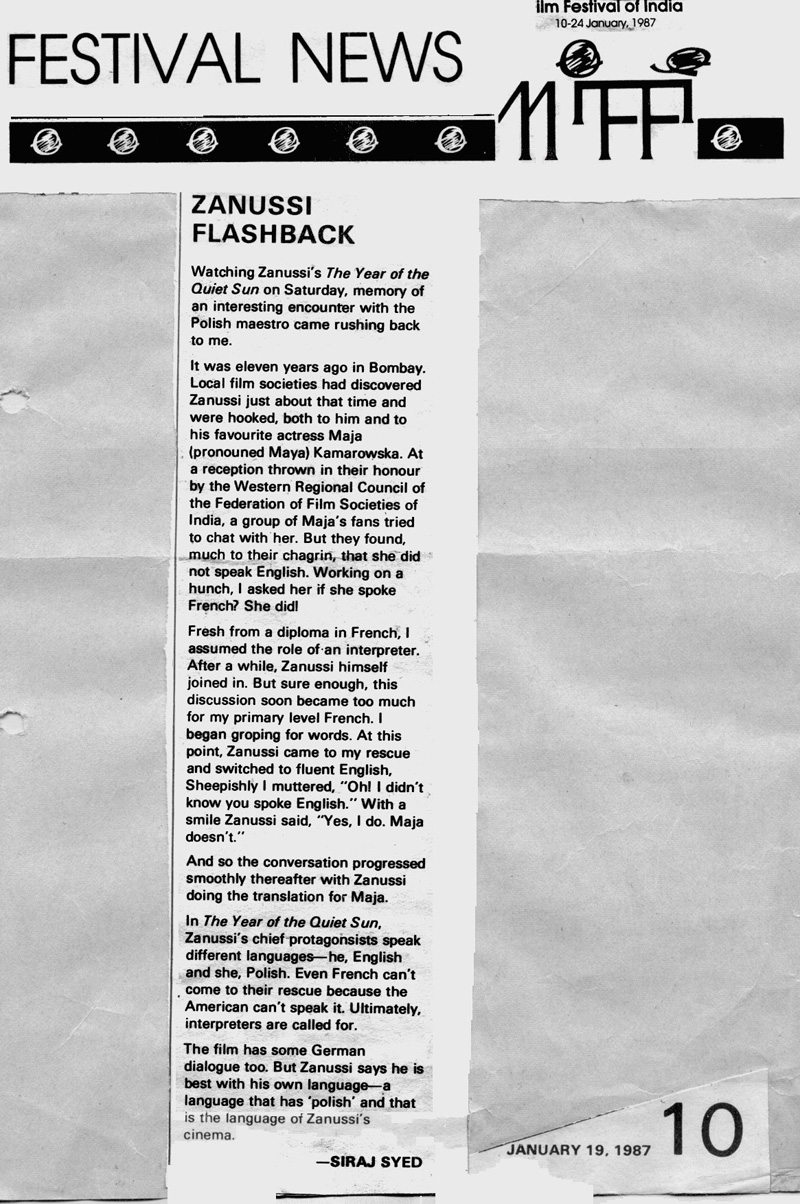|
|
||
|
Pro Tools
FILMFESTIVALS | 24/7 world wide coverageWelcome ! Enjoy the best of both worlds: Film & Festival News, exploring the best of the film festivals community. Launched in 1995, relentlessly connecting films to festivals, documenting and promoting festivals worldwide. Working on an upgrade soon. For collaboration, editorial contributions, or publicity, please send us an email here. User login |
Kalank, Review: Masochistic miasma
Kalank, Review: Masochistic miasma Everything in Kalank (blemish, stigma) is grand, both in content and in form. Sets and décor, riches and poverty, locales and vehicles, make-up and costumes, dances and fights, colours and luminance, all are designed to make your jaw drop in awe. All this opulence is merely the canvas on which a heart-wrenching tragedy is painted, around the time of India’s partition, with the entire ensemble cast at the receiving end of a woeful operatic wail, staged by a miserable, relentless destiny. Where did director-screenplay writer Abhishek Varman pick-up his predilections? The visual riot and the epic melancholia might suggest the Sanjay Leela Bhansali insignia. But a look at Varman’s bio will reveal that he assisted Ashutosh Gowariker in Jodhaa Akbar, and Gowariker too is no mean dabbler in historic spectacle himself. So, it's a bit of both. Roots of Kalank are spread across 15 years, when producer Karan Johar and his father, late Yash Johar, first conceived the plot. Developed by Shibani Bathija (Kabhi Alvida Naa Kehna, My Name Is Khan, Fanaa; all big banner enterprises), it was written for the screen by Abhishek himself, who had earlier adapted the Chetan Bhagat novel, 2 States, which he directed as his debut vehicle. Dialogue for Kalank comes from the pen of Hussain Dalal, Varman’s dialogue-writer in 2 States, who also penned dialogue for Karwaan and Fanney Khan. In 1945, a young woman, Satya, married into a newspaper publishing family in colonial Lahore, approaches her childhood friend Roop, with a strange request: she is suffering from cancer, and is likely to die in about a year. She requests Roop, to provide companionship to her husband, Dev Chaudhry, and marry him after her death, if she is agreeable. The eldest daughter of a music teacher, Roop is at first shocked at the audacity of her friend, but her father reminds her that he will be unable to meet the marriage expenses of his daughters from his meagre income. Roop finally agrees, but on the condition that Dev take her as his second wife while Satya is still alive, though only in name, purely platonic. Now relocated to Lahore, and living a strange life, a depressed Roop takes solace in music. Hearing the song of a woman singing across the lake, she decides that this is the person she would like to have as her ustaad (teacher, guru). The singer is none other than Bahaar Begum, the tawaif (courtesan), who is the most popular denizen of the notorious HiraMandi. For a daughter-in-law of the Chaudhry family, going to HiraMandi and learning music from Bahaar is out of question. But Roop is insistent. Giving in to her, the family arranges to have her escorted to the kotha (courtesan’s abode). On one such visit, she encounters the smooth-talking, womanising, hunk-of-a-blacksmith, Zafar. As she is drawn to him, little does she know that he is the illegitimate son of Balraj Chaudhry, Roop’s father-in-law, and Bahaar, and is out to wreak vengeance, for the fate they left him to. Meanwhile, as the landmark year of 1947, when India won independence and the country was bifurcated into India and Pakistan, is approaching, a political storm is brewing across the sub-continent, that will pit Dev Chaudhry’s family against Zafar’s boss, Abdul Khan, who is a political activist-turned-religious fanatic. Almost all character journeys in Kalank begin with dead-ends. Satya will die after one year. God knows what misfortune will befall her unmarried sisters and poverty-stricken father. Roop will be torn apart between Dev and Zafar, when things come to a boil, Bahaar will die defending her Hindu sisters from rioting Muslim mobs, Zafar will die protecting Roop and Dev, Dev’s staff will be murdered before his eyes, Roop’s ‘keeper’ Saroj will be killed too, and, lastly, Roop and Dev will have to live out a loveless life, with Balraj for company. Only the fundamentalist Abdul and the unethical and ambi-moralistic Chaudhry patriarch will emerge alive, but neither deserves the sympathy of the audience. And the most gory death is reserved for the man who is the biggest victim of circumstances that were not of his own doing. Sixty years ago, such stories were called the South or the Madras formula, wherein people kept dying one after the other, either due to disease, poverty or accidents. In terms of genre, such films were called tear-jerkers. Kalank is a tear-jerker of waterfall dimensions. A length of 166 minutes is justified considering the developments that move in stages and chapters, though attention to detail is not the film’s forté. Why did Roop want to learn singing only from Bahaar? Just because it was her voice that wafted in from miles away when she was in a music-learning mode? Why did Balraj not put his foot down when Roop wanted to learn singing from Bahaar, as he should have? Where is HiraMandi in relation to the Chaudhry manor? Sometimes they go by boat, sometimes by car, sometimes by horse-cart! Why are large crowds waiting for a signal to start singing, dancing, emerging from the water, or being suspended on ropes in elaborately choreographed steps? Why are all the umbrellas white, with a red centre, when Zafar rushes out to save the Chaudhry household? Does the Chaudhry family have only one retainer, the woman called Saroj, who accompanies her to the kotha? None other is seen. And why is she missing when almost all the encounters with Zafar take place? Why is Satya’s pyre lit in total seclusion, with only her husband and father-in-law present? Why consummate a marriage when neither party is interested in a conjugal future? The flashback in the form of an interview of the survivors who escape to Amritsar fails to add any meaning to the proceedings. When everything is so morose and morbid, it is difficult to offset the happenings with witty or pithy dialogue. In any case, what we have is neither witty not pithy, but contrived to appear so. Characterisation is never developed or enunciated through dialogue, although a lot of it seems to emanate naturally from the personalities. Lines become poetic when you least expect them to and turn prosaic when a layered exchange was called for. Stating the obvious, which is usually sad and bitter, is the norm. Lyrics and music, by contrast, do add some splashes to the barren parts of the canvas: ‘Ghar more pardesiya’, ‘First class’ and ‘Aira ghaira’ provide melodious threads to the narrative fabric. Composer Pritam, lyricist Amitabh Bhattacharya and singers Arijit Singh, Shreya Ghoshal, Antara Mitra, Javed Ali and Tushar Joshi make good contributions here. The other tracks, including some repetitions, are not up to the mark. Varman’s direction succeeds in bringing out the angst of the characters, yet they often remain uni-dimensional. That is rather odd, for all of them are given the backdrops of their natural milieus. He has adopted the democratic distribution of footage axiom, since he has so many lead players at his disposal. Only Sonakshi Sinha ends up with a shortish role, but with nothing less than a ‘death by cancer’ reason. Such fair-play works on occasions. On others, it short-changes everyone and denies the film a clear focus. A never-ending climax at a railway station and inside the train’s compartments, as the train begins to crawl into motion, is too cyclic and long-drawn to appear credible, though the junior artistes are all doing their jobs wonderfully well. Taking the film to a kind of gory crescendo, Abhishek Varman reserves the most cruel fate for his romantic hero. Pray, why? Every time two characters are in a dramatic confrontation, and the camera starts panning, you know that it will now reveal the third character, who has entered the frame unnoticed (no fault, I presume, of Binod Pradhan, the cinematographer, who has done a splendid job). And fire, in all forms and shapes, keeps appearing as a regular motif. Shweta Venkat Mathew’s editing is fluid, with most scenes blending unnoticed, though this also in part due to the similarities of many successive shots. Production Design by Kshamata Sachin Gurav and Amrita Mahal, and Set Decoration by Pravin Tambe, are of a high order, considering many sets and several locations were involved. (It might be mentioned here that Abhishek Varman is the son of vetreran art director, R. Varman/Verman). Costume Design by Maxima Basu shows a taste for the mellow, without compromising on the richness of texture, as dictated by the film. Ali Merchant makes judicious use of the sound design, though the climax, especially the train scenes, could have been better mixed. In terms of action sequences, the main sequences would have been the bull-fight and the climax. VFX would take care of the bull-fight, while Sham Kaushal, the action director, would have been ‘put to the sword’ time and again. Madhuri Dixit (51) came in for Bahaar when the Johars’ first choice Sreedevi passed away. When a kotha, singing and some dancing are involved, and the woman has a son the age of Varun Dhawan, who can be faulted for choosing Dixit, a well-trained danseuse, who has played the kothewali to perfection in Bhansali’s Devdas? She is good, within the confines of a one point chart. Sonakshi Sinha (Satya)’s last scene, when a tear-drop quietly trickles down her cheek, tugs at your heart. Alia Bhatt has a face that can arouse sympathy with little effort, but here she shows many more facets of her acting range. Shown as a hunk having muscles that would do any WWE muscleman proud, Varun Dhawan (Zafar) suffers from being put on a uni-track rink, though he tries very hard to rise above the script. Saddled with too much fighting action and the ‘bastard child’ refrain, he makes you want more from him. Surprise packet Aditya Roy Kapur underplays Dev and remains in character throughout the film. Sanjay Dutt as Balraj does not bring any great value to the cast (he reportedly left the film before it had started, but was wooed back) while Kunal Khemmu’s chameleonic character changes colours with every passing shot, though not without cinematic reason. Kiara Advani and Kriti Sanon are there to provide svelte, seductive bodies, as bed-mates and dance-partners. If empathy is your weakness and sympathy your sentiment, you may see in Kalank more than what the detached, objective film-goer might. After you have wiped your tears, and regained your composure, you are not likely to think too much of this masochistic miasma. Rating: ** ½ Trailer: https://youtu.be/p4Z_ueeT_XQ 18.04.2019 | Siraj Syed's blog Cat. : Abhishek Varman Aditya Roy Kapur Ali Merchant Alia Bhatt Amitabh Bhattacharya Amrita Mahal Antara Mitra Binod Pradhan Hussain Dalal Javed Ali Karan Johar Kiara Advani Kriti Sanon Kshamata Sachin Gurav Kunal Khemmu Madhuri Dixit Maxima Basu Pravin Tambe Pritam Sanjay Dutt Sham Kaushal Shibani Bathija Shreya Ghoshal Shweta Venkat Mathew Singh Sonakshi Sinha Tushar Joshi Varun Dhawan Independent FILM
|
LinksThe Bulletin Board > The Bulletin Board Blog Following News Interview with IFTA Chairman (AFM)
Interview with Cannes Marche du Film Director
Filmfestivals.com dailies live coverage from > Live from India
Useful links for the indies: > Big files transfer
+ SUBSCRIBE to the weekly Newsletter Deals+ Special offers and discounts from filmfestivals.com Selected fun offers
> Bonus Casino
User imagesAbout Siraj Syed Syed Siraj Syed Siraj (Siraj Associates) Siraj Syed is a film-critic since 1970 and a Former President of the Freelance Film Journalists' Combine of India.He is the India Correspondent of FilmFestivals.com and a member of FIPRESCI, the international Federation of Film Critics, Munich, GermanySiraj Syed has contributed over 1,015 articles on cinema, international film festivals, conventions, exhibitions, etc., most recently, at IFFI (Goa), MIFF (Mumbai), MFF/MAMI (Mumbai) and CommunicAsia (Singapore). He often edits film festival daily bulletins.He is also an actor and a dubbing artiste. Further, he has been teaching media, acting and dubbing at over 30 institutes in India and Singapore, since 1984.View my profile Send me a message The EditorUser contributions |



















